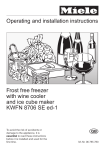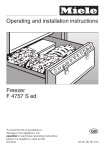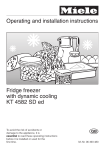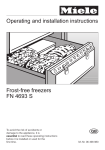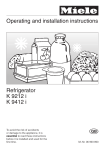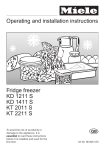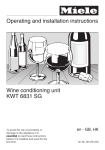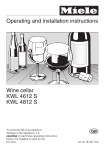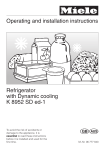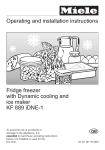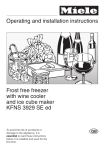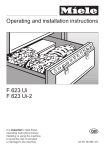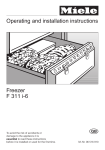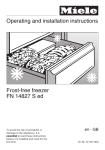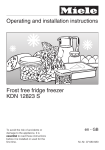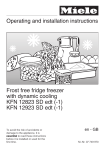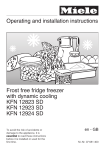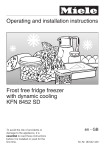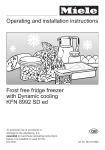Download Miele KWFN 8705 SE ed Operating instructions
Transcript
Operating and installation instructions Frost free freezer with wine cooler and ice cube maker KWFN 8705 SE ed To avoid the risk of accidents or damage to the appliance, it is essential to read these operating instructions before it is installed or used for the first time. G M.-Nr. 06 224 110 Contents Description of the appliance . . . . . . . . . . . . . . . . . . . . . . . . . . . . . . . . . . . . . . . . . 4 Caring for the environment . . . . . . . . . . . . . . . . . . . . . . . . . . . . . . . . . . . . . . . . . . 6 Warning and Safety instructions . . . . . . . . . . . . . . . . . . . . . . . . . . . . . . . . . . . . . 7 How to save energy . . . . . . . . . . . . . . . . . . . . . . . . . . . . . . . . . . . . . . . . . . . . . . . 11 Switching on and off . . . . . . . . . . . . . . . . . . . . . . . . . . . . . . . . . . . . . . . . . . . . . . 12 Wine cooler . . . . . . . . . . . . . . . . . . . . . . . . . . . . . . . . . . . . . . . . . . . . . . . . . . . . 12 Freezer section . . . . . . . . . . . . . . . . . . . . . . . . . . . . . . . . . . . . . . . . . . . . . . . . . 12 Safety lock . . . . . . . . . . . . . . . . . . . . . . . . . . . . . . . . . . . . . . . . . . . . . . . . . . . . . . . 13 Switching off for longer periods of time . . . . . . . . . . . . . . . . . . . . . . . . . . . . . . . . . 13 Temperature displays . . . . . . . . . . . . . . . . . . . . . . . . . . . . . . . . . . . . . . . . . . . . . 14 Temperature display brightness . . . . . . . . . . . . . . . . . . . . . . . . . . . . . . . . . . . . 14 Alarm . . . . . . . . . . . . . . . . . . . . . . . . . . . . . . . . . . . . . . . . . . . . . . . . . . . . . . . . . . . 16 Temperature alarm . . . . . . . . . . . . . . . . . . . . . . . . . . . . . . . . . . . . . . . . . . . . . . . . . 16 Door alarm . . . . . . . . . . . . . . . . . . . . . . . . . . . . . . . . . . . . . . . . . . . . . . . . . . . . . . . 16 Switching on the alarm system . . . . . . . . . . . . . . . . . . . . . . . . . . . . . . . . . . . . . . . 16 Switching the alarm off early . . . . . . . . . . . . . . . . . . . . . . . . . . . . . . . . . . . . . . . . . 16 Using the wine cooler . . . . . . . . . . . . . . . . . . . . . . . . . . . . . . . . . . . . . . . . . . . . . 17 The correct temperature . . . . . . . . . . . . . . . . . . . . . . . . . . . . . . . . . . . . . . . . . . . . 17 Setting the temperature in the wine cooler . . . . . . . . . . . . . . . . . . . . . . . . . . . . . . 17 Temperature range . . . . . . . . . . . . . . . . . . . . . . . . . . . . . . . . . . . . . . . . . . . . . . 17 Dynamic cooling m . . . . . . . . . . . . . . . . . . . . . . . . . . . . . . . . . . . . . . . . . . . . . . . 18 Switching on Dynamic cooling . . . . . . . . . . . . . . . . . . . . . . . . . . . . . . . . . . . . . 18 Switching off Dynamic cooling . . . . . . . . . . . . . . . . . . . . . . . . . . . . . . . . . . . . . 18 Storing wine bottles. . . . . . . . . . . . . . . . . . . . . . . . . . . . . . . . . . . . . . . . . . . . . . . 20 Wooden shelf fronts . . . . . . . . . . . . . . . . . . . . . . . . . . . . . . . . . . . . . . . . . . . . . . . . 20 Descriptive labels . . . . . . . . . . . . . . . . . . . . . . . . . . . . . . . . . . . . . . . . . . . . . . . . . 20 Using the freezer section . . . . . . . . . . . . . . . . . . . . . . . . . . . . . . . . . . . . . . . . . . 21 The correct temperature . . . . . . . . . . . . . . . . . . . . . . . . . . . . . . . . . . . . . . . . . . . . 21 Setting the temperature in the freezer section. . . . . . . . . . . . . . . . . . . . . . . . . . . . 21 Temperature range . . . . . . . . . . . . . . . . . . . . . . . . . . . . . . . . . . . . . . . . . . . . . . 21 Freezing fresh food . . . . . . . . . . . . . . . . . . . . . . . . . . . . . . . . . . . . . . . . . . . . . . . . 22 Super freeze. . . . . . . . . . . . . . . . . . . . . . . . . . . . . . . . . . . . . . . . . . . . . . . . . . . . . . 22 Switching on Super freeze . . . . . . . . . . . . . . . . . . . . . . . . . . . . . . . . . . . . . . . . 22 Switching off Super freeze . . . . . . . . . . . . . . . . . . . . . . . . . . . . . . . . . . . . . . . . 23 Freezing and storing food . . . . . . . . . . . . . . . . . . . . . . . . . . . . . . . . . . . . . . . . . . . 23 Maximum freezing capacity . . . . . . . . . . . . . . . . . . . . . . . . . . . . . . . . . . . . . . . 23 Storing frozen food . . . . . . . . . . . . . . . . . . . . . . . . . . . . . . . . . . . . . . . . . . . . . . 23 Contents Home freezing . . . . . . . . . . . . . . . . . . . . . . . . . . . . . . . . . . . . . . . . . . . . . . . . . . . . 24 Hints on home freezing. . . . . . . . . . . . . . . . . . . . . . . . . . . . . . . . . . . . . . . . . . . 24 Packing . . . . . . . . . . . . . . . . . . . . . . . . . . . . . . . . . . . . . . . . . . . . . . . . . . . . . . . 24 Before placing food in the freezer section . . . . . . . . . . . . . . . . . . . . . . . . . . . . 25 Placing food in the freezer section . . . . . . . . . . . . . . . . . . . . . . . . . . . . . . . . . . 25 Freezer calendar . . . . . . . . . . . . . . . . . . . . . . . . . . . . . . . . . . . . . . . . . . . . . . . . . . 25 Marker system for frozen food . . . . . . . . . . . . . . . . . . . . . . . . . . . . . . . . . . . . . . . . 26 Defrosting. . . . . . . . . . . . . . . . . . . . . . . . . . . . . . . . . . . . . . . . . . . . . . . . . . . . . . . . 26 Cooling drinks . . . . . . . . . . . . . . . . . . . . . . . . . . . . . . . . . . . . . . . . . . . . . . . . . . . . 27 Freezer tray . . . . . . . . . . . . . . . . . . . . . . . . . . . . . . . . . . . . . . . . . . . . . . . . . . . . . . 27 Cool pack. . . . . . . . . . . . . . . . . . . . . . . . . . . . . . . . . . . . . . . . . . . . . . . . . . . . . . . . 27 Ice cube maker . . . . . . . . . . . . . . . . . . . . . . . . . . . . . . . . . . . . . . . . . . . . . . . . . . . 28 Defrosting . . . . . . . . . . . . . . . . . . . . . . . . . . . . . . . . . . . . . . . . . . . . . . . . . . . . . . . 30 Cleaning and care . . . . . . . . . . . . . . . . . . . . . . . . . . . . . . . . . . . . . . . . . . . . . . . . 31 Cleaning the outer casing, the interior and accessories . . . . . . . . . . . . . . . . . . . . 31 Cleaning the ice cube tray. . . . . . . . . . . . . . . . . . . . . . . . . . . . . . . . . . . . . . . . . . . 31 Ventilation gaps . . . . . . . . . . . . . . . . . . . . . . . . . . . . . . . . . . . . . . . . . . . . . . . . . . . 32 Door seals . . . . . . . . . . . . . . . . . . . . . . . . . . . . . . . . . . . . . . . . . . . . . . . . . . . . . . . 32 Metal grille at the back of the appliance . . . . . . . . . . . . . . . . . . . . . . . . . . . . . . . . 33 Active charcoal filter . . . . . . . . . . . . . . . . . . . . . . . . . . . . . . . . . . . . . . . . . . . . . . . 33 Problem solving guide. . . . . . . . . . . . . . . . . . . . . . . . . . . . . . . . . . . . . . . . . . . . . 34 Noises . . . . . . . . . . . . . . . . . . . . . . . . . . . . . . . . . . . . . . . . . . . . . . . . . . . . . . . . . 37 Service Department . . . . . . . . . . . . . . . . . . . . . . . . . . . . . . . . . . . . . . . . . . . . . . . 38 Mains water connection . . . . . . . . . . . . . . . . . . . . . . . . . . . . . . . . . . . . . . . . . . . 39 Notes on connecting to the mains water supply . . . . . . . . . . . . . . . . . . . . . . . . . . 39 Connection to the water inlet . . . . . . . . . . . . . . . . . . . . . . . . . . . . . . . . . . . . . . . . . 40 Electrical connection . . . . . . . . . . . . . . . . . . . . . . . . . . . . . . . . . . . . . . . . . . . . . . 41 Electrical connection U.K. . . . . . . . . . . . . . . . . . . . . . . . . . . . . . . . . . . . . . . . . . . . 41 Installation . . . . . . . . . . . . . . . . . . . . . . . . . . . . . . . . . . . . . . . . . . . . . . . . . . . . . . 43 Location . . . . . . . . . . . . . . . . . . . . . . . . . . . . . . . . . . . . . . . . . . . . . . . . . . . . . . . . . 43 Climate range . . . . . . . . . . . . . . . . . . . . . . . . . . . . . . . . . . . . . . . . . . . . . . . . . . 43 Ventilation. . . . . . . . . . . . . . . . . . . . . . . . . . . . . . . . . . . . . . . . . . . . . . . . . . . . . . . . 43 Installation . . . . . . . . . . . . . . . . . . . . . . . . . . . . . . . . . . . . . . . . . . . . . . . . . . . . . . . 43 Aligning the appliance . . . . . . . . . . . . . . . . . . . . . . . . . . . . . . . . . . . . . . . . . . . . . . 43 Changing the door hinging . . . . . . . . . . . . . . . . . . . . . . . . . . . . . . . . . . . . . . . . . 44 Building in the appliance . . . . . . . . . . . . . . . . . . . . . . . . . . . . . . . . . . . . . . . . . . 47 Description of the appliance a Wine cooler On/Off button f Freezer section On/Off button b Wine cooler temperature display g Freezer section temperature display c Wine cooler temperature selector buttons left hand button: warmer right hand button: colder d Dynamic cooling / constant humidity button and indicator light e Safety lock indicator light 4 h Freezer section temperature selector buttons left hand button: warmer right hand button: colder i Super freeze button and indicator light j Alarm off button Description of the appliance a Wooden shelf front with descriptive labels b Active charcoal filter c Condensate channel and drain hole d Ice cube drawer with automatic ice cube maker e Freezer drawers with freezer calendar f Marker system for frozen food 5 Caring for the environment Disposal of packing material The transport and protective packing has been selected from materials which are environmentally friendly for disposal and can normally be recycled. Ensure that any plastic wrappings, bags etc. are disposed of safely and kept out of the reach of babies and young children. Danger of suffocation! Rather than just throwing these materials away, please ensure that they are recycled. Disposal of your old appliance Old appliances contain materials which can be reclaimed or recycled. Please contact your dealer, your local waste collection centre or scrap merchant about potential recycling schemes. Take care not to damage the pipework at the back of the appliance before or during transportation to an authorised collection depot. In this way, refrigerant in the pipework and oil in the compressor will be contained, and will not leak out into the environment. Ensure that the appliance presents no danger to children while being stored for disposal. See the appropriate section in the Warning and Safety instructions. 6 Warning and Safety instructions Technical safety This appliance complies with all relevant legal safety requirements. Improper use of the appliance can, however, present a risk of both personal injury and material damage. Before installation and before using for the first time, read the operating instructions carefully. They contain important notes on installation, safety, operation and care of the appliance. This way you will avoid the risk of accidents and damage to the appliance. This appliance is not a toy! To avoid the risk of injury, do not allow children to play on or near it, or to play with the controls. Supervise its use by the elderly or infirm Keep these operating instructions in a safe place and pass them on to any future user. Correct use This appliance is intended for domestic use only for storing wine as well as for storing deep frozen food, freezing fresh food and for preparing ice. Any other usage is not supported by the manufacturer and could be dangerous. The manufacturer cannot be held liable for damage caused by incorrect or improper use of the appliance. This appliance contains the coolant Isobutane (R600a), a natural gas which is environmentally friendly. Although it is flammable, it does not damage the ozone layer and does not increase the greenhouse effect. The use of this environmentally friendly coolant has, however, led to a slight increase in the noise level of the appliance. In addition to the noise of the compressor, you might be able to hear the coolant flowing around the system. This is unavoidable, but does not have any adverse effect on the performance of the appliance. Care must be taken during transportation and setting up of the appliance that no parts of the cooling system are damaged. Leaking coolant can damage the eyes. In the event of any damage: - avoid open fires and anything which creates a spark, - disconnect from the mains, - air the room in which the appliance is located for several minutes and - contact the Service Department for advice. The more refrigerant there is in an appliance, the larger the room it should be installed in. In the event of a leakage, if the appliance is in a small room, there is the danger of combustible gases building up. For every 8 g of coolant at least 1 m3 room space is required. The amount of coolant in the appliance is stated on the data plate inside the appliance. 7 Warning and Safety instructions Before connecting the appliance to the mains supply make sure that the rating on the data plate corresponds to the voltage and frequency of the household supply. This data must correspond in order to avoid risk of damage to the appliance. If in any doubt, consult a qualified electrician. The electrical safety of this appliance can only be guaranteed when continuity is complete between the appliance and an effective earthing system, which complies with local and national safety regulations. It is most important that this basic safety requirement is present and regularly tested and where there is any doubt the household wiring system should be inspected by a qualified electrician. The manufacturer cannot be held liable for the consequences of an inadequate earthing system (e.g. electric shock). Safe operation of the appliance is only assured if it has been installed and connected in accordance with these operating and installation instructions. This equipment may only be used in mobile installations such as ships, caravans, aircraft etc. if a risk assessment of the installation has been carried out by a suitably qualified engineer. Installation work, maintenance and repairs may only be carried out by suitably qualified and competent persons to ensure safety. Repairs and other work by unqualified persons could be dangerous and the manufacturer will not be held liable. 8 The manufacturer cannot be held liable for damage due to a faulty connection to the mains water supply. Connection to the mains water supply and any repairs to the ice cube maker must only be carried out by a suitably qualified and competent person. The ice cube maker is not suitable for connection to a hot water supply. Before making plumbing connections, ensure the appliance is disconnected from the mains electricity supply. The appliance is only completely isolated from the electricity supply when: – it has been switched off at the wall socket and the plug removed, – the fuse from the fused spur connection unit is withdrawn, or – the screw-out fuse is removed (in countries where this is applicable). Do not connect the appliance to the mains electricity supply by an extension lead. Extension leads do not guarantee the required safety of the appliance (e.g. danger of overheating). Warning and Safety instructions Use Never handle frozen food with wet hands. Your hands may freeze to the frozen food. Danger of injury. Do not take ice cubes out with your bare hands and never place ice cubes or ice lollies in your mouth straight from the freezer. The very low temperature of the frozen ice or lollies can cause frost burn to the lips and tongue. Do not refreeze thawed or partially thawed food. Defrosted food should be used up as quickly as possible as food soon loses its nutritional value and goes off. Defrosted food may only be re-frozen after it has been cooked. Do not store explosive materials in the appliance or any products containing propellants (e.g. spray cans). Thermostats switching on may produce sparks which could present a fire hazard. If storing alcohol with a high percentage proof, make sure it is tightly closed and stored upright. Danger of explosion. Do not store cans or bottles containing carbonated drinks or liquids which could freeze in the freezer. The cans or bottles could explode. Danger of injury and damage to the appliance. When cooling drinks quickly in the freezer make sure bottles are not left in for more than one hour, otherwise they could burst. Danger of injury and damage to the appliance. Observe the "use by" dates given on food to avoid the risk of food poisoning. Storage times will depend on several factors including the freshness and quality of the food as well as the temperature at which it is stored. Follow the instructions given on food manufacturer's packaging on storage conditions required as well as the "use by" date. Do not use sharp edged objects to – remove frost and ice, – separate frozen foods and remove ice trays. They will damage the evaporator causing irreversible damage to the appliance. Never place electric heaters or candles in the appliance to defrost it. These can damage the plastic parts. Do not use defrosting sprays, or de-icers as they could contain substances which could damage the plastic parts and which may cause the build up of gases and pose a danger to health. Do not use any oils or grease on the door seals as these will cause the seals to deteriorate and become porous with time. 9 Warning and Safety instructions Do not block the ventilation grilles in the appliance as this would impair the efficiency of the appliance, increase the electricity consumption and could cause damage to the appliance. The appliance is designed for use within certain climate ranges (ambient temperatures) and should not be used outside this range. The climate range for your appliance is stated on the data plate inside the appliance. Installing it in a room with too low an ambient temperature, e.g. a garage, will lead to the appliance switching off for longer periods so that it cannot maintain the required temperature. Never use a steam-cleaning appliance to defrost or clean this appliance. Pressurised steam could reach the electrical components and cause a short circuit. In countries where there are areas which may be subject to infestation by cockroaches or other vermin, pay particular attention to keeping the appliance and its surrounding in a clean condition at all times. Any damage which may caused by cockroaches or vermin will not be covered by the appliance guarantee. 10 Disposal of your old appliance Before disposing of an old appliance first make the door latch or lock unusable. This way you will prevent children from accidentally locking themselves in and endangering their lives. Before disposing of an old appliance, unplug it and render the plug unusable. Cut off the cable directly behind the appliance and at the plug to prevent misuse. Be careful not to damage any part of the pipework whilst awaiting disposal, e.g. by – puncturing the refrigerant channels in the evaporator. – bending any pipework. – scratching the surface coating. Splashes of refrigerant can damage the eyes. The manufacturer cannot be held liable for damage caused by non-compliance with these Warning and safety instructions. How to save energy Installation normal energy consumption increased energy consumption In a ventilated room. In an enclosed, unventilated room. Protected from direct sunlight. In direct sunlight. Not situated near to a heat source (radiator, oven). Situated near to a heat source (radiator, oven). Where the ambient room temperature is ideal at approx. 20°C. Where there is a high ambient room temperature. Temperature setting with With a medium setting of 2 to 3. a thermostat which is approximate (set in stages). With a high setting: The lower the compartment temperature, the higher the energy consumption. Temperature setting with Cellar section 8 to 12°C a thermostat which is Refrigerator section 4 to 5 °C exact to the degree (digital display). StayFresh zone approx. 0°C Freezer section -18°C On appliances with winter setting, please make sure that the winter setting is switched off when the ambient temperature is warmer than 16 °C. Only open the door when necessary and for as short a time as possible. Frequent opening of the door for long periods will cause a loss of coldness. Store food in an organised way. If food is not stored in an organised way, searching for an item will mean the door is open for longer. Allow hot food and drinks to cool down before placing them in the appliance. Placing hot food in the appliance will cause the compressor to run for a long time, as the appliance will have to work harder to lower the temperature. Store food covered or packaged. The evaporation or condensation of liquids will cause a loss of coldness in the refrigerator. Use Place frozen food in the refrigerator to defrost. Do not over-fill the sections to allow air to circulate. Defrosting Defrost the freezer section when a layer of ice one centimetre thick has built up. A layer of ice hinders the cold from reaching the frozen food, and causes an increase in energy consumption. 11 Switching on and off Before using for the first time Freezer section The stainless steel surface has a layer of protective foil to prevent scratching during transportation. ^ Do not remove this foil until the appliance has been installed or built in. Start at one of the upper corners. ^ Clean the inside of the appliance and the accessories with warm water and a little washing up liquid, and then dry with a soft cloth. Important: To ensure the correct functioning of the appliance, let it stand for between ½ and 1 hour after transporting it to its final location before connecting it to the mains. Switching on The wine cooler and freezer section are switched on independently of one another so that, if required, you can switch on only one. Wine cooler ^ Press the wine cooler On/Off button on the left hand side of the control panel. The wine cooler temperature display will light up and the wine cooler starts cooling. 12 ^ Press the freezer section On/Off button on the right hand side of the control panel. Bars light up in the freezer section temperature display and the freezer section starts cooling. Allow the appliance to run for a few hours before placing food in it. This will ensure that the temperature is sufficiently low. Cool pack Place the cool pack in the top freezer drawer or to save space on the freezer tray. The cool pack will be at its most effective after it has been in the freezer for approx. 24 hours. Switching off ^ Press the appropriate On/Off button until the temperature display goes out. The cooling system is switched off. If this does not happen, then the safety lock has been activated. Switching on and off Safety lock The safety lock can be activated to prevent the appliance being switched off inadvertently. Activating or de-activating the safety lock ^ Press the freezer section On/Off button to come out of the setting mode. The electronics will then switch over to normal operation after a couple of minutes. ^ Press and hold the Super freeze button for approx. 5 seconds. Switching off for longer periods of time The Super freeze indicator light flashes and a ; flashes in the temperature display. If the appliance is not going to be used for a longer period of time, e.g. whilst on holiday, ^ Press the Super freeze button again. ^ switch the appliance off, ; lights up in the temperature display. ^ switch off at the wall socket and withdraw the plug, ^ close the stopcock for the water inlet, ^ clean the appliance out and ^ You can now choose between ; 0 and ; 1 by pressing the temperature selector buttons: 0: the safety lock is de-activated, 1: the safety lock is activated. ^ Press the Super freeze button to save the setting. The safety lock indicator light X will light up when the safety lock has been activated. ^ leave the doors ajar to air the appliance. If, during a long absence, the appliance is switched off but not cleaned out and the doors are left shut, there is a danger of mould and odours building up inside the appliance. 13 Temperature displays During normal operation the temperature displays show the average temperature in the wine cooler and the temperature in the warmest part of the freezer section. If the temperature in the appliance is not within the range that the appliance is able to display (above 0 °C in the wine cooler, and below 0 °C in the freezer section), bars will flash in the temperature displays. Depending on the ambient temperature and the setting, it can take the appliance up to 8 hours to reach the temperature required and for this temperature to then be shown as a constant temperature in the display. The temperature displays flash, if – if the ambient temperature surrounding the appliance is too high. The appliance is designed for use in specific ambient temperatures (climate ranges). Do not use in ambient temperatures for which it is not designed. Temperature display brightness The appliance is supplied with the brightness of the temperature display set as low as possible. However, if the door is opened, a setting changed or if the alarm is sounding, the temperature display will appear much brighter for approx. 1 minute. You can adjust the level of brightness: – a different temperature is being set, – the temperature in the wine cooler is too low, – the temperature in the appliance has risen by several degrees, indicating that the appliance is warming up too much. A loss of coldness in the freezer section is no cause for concern in the following circumstances: – when the door has been left open for a while, e.g. for removing or storing a large amount of food, – when freezing large amounts of food at once, – if the temperature of the food you have recently placed in the freezer section is too warm, 14 ^ Press and hold the Super freeze button for approx. 5 seconds. The Super freeze indicator light flashes and a ; flashes in the temperature display. ^ Press one of the temperature selector buttons repeatedly until an ^ appears in the display. ^ Press the Super freeze button again. ^ lights up in the temperature display. Temperature displays ^ You can now adjust the level of brightness by pressing the temperature selector buttons. You can choose from settings 1 to 5: 1: lowest setting, 5: brightest setting. ^ Press the Super freeze button to save the setting. ^ Press the freezer section On/Off button to come out of the setting mode. The electronics will then switch over to normal operation after a couple of minutes. 15 Alarm Your appliance has been fitted with a warning system to protect your stored wine and frozen food from a change in temperature and also to save energy. Door alarm Temperature alarm The alarm will stop as soon as the door is closed. An alarm will sound and the relevant temperature display will flash, if the temperature in the wine cooler is too cold or too warm or if the temperature in the freezer section is not cold enough. The temperature the appliance is set at determines the temperature the appliance recognises as being too warm or too cold. The alarm will sound and the relevant temperature display will also flash: – when freezing large amounts of food at once. – if the doors have been left open for a while, e.g. in order to load, to re-arrange or to take out frozen food or wine bottles. The temperature display continues to flash until the set temperature has been reached. 16 If one of the doors has been left open for more than approx. 60 seconds the alarm will sound. Switching on the alarm system The alarm system is always active. It does not have to be switched on manually. Switching the alarm off early Once the set temperature has been reached in the wine cooler or the freezer section, the alarm switches off and the temperature display stops flashing and lights up constantly. However, if the noise disturbs you, you can turn the alarm off before this if you wish. ^ Press the alarm off button. The alarm will stop. The relevant temperature display will continue to flash until the set temperature has been reached. The display then stops flashing and lights up constantly. The alarm system is now ready should it be needed again. Using the wine cooler Wine keeps on maturing depending on the surrounding conditions. The length of time for which wine can be kept in good condition will depend on the temperature but also the air humidity. Setting the temperature in the wine cooler The correct temperature Press the Wine can be stored at a temperature between 5°C and 18°C. The optimum temperature is around 8 - 12°C. Most white wines can be consumed at this temperature. It is best to take red wine out of the wine cooler about two hours before drinking. Open the wine to allow it to breathe and to develop its aroma. After two hours red wine will be at the correct temperature for drinking. left hand button: If wine is stored at a temperature above 22°C it will mature too quickly. Wine should not be stored below 5°C for a long period of time as it will not mature fully at this low temperature. After setting the temperature you can see the following information in the display by pressing the +/- buttons: Fluctuations in temperature put wine under stress and interrupt the maturing process. It is therefore very important to maintain a constant temperature. Safety feature A thermostat prevents the temperature in the wine cooler falling below 2°C. If the external temperature should drop below this level, a heater element in the appliance switches on automatically to keep the temperature inside as constant as possible. Use the two buttons underneath wine cooler temperature display to set the temperature. right hand button: to raise the temperature to reduce the temperature. The temperature being set will flash in the display. – When first pressed: the last temperature selected flashes. – Each subsequent press of the button adjusts the temperature shown in 1 °C steps. – Keeping the button pressed in adjusts the temperature continually. Approx. 5 seconds after letting go of the button, the current actual temperature of the wine cooler is automatically shown. Temperature range The temperature can be adjusted from 5 °C to 18 °C. 17 Using the wine cooler Humidity It is very important to store wine in an atmosphere with a high humidity level (60 - 70 %) so that the corks remain moist on the outside. A refrigerator with its low humidity level is therefore not the best place to store wine. At a low humidity level corks dry out from the outside and so do not seal the bottles as tightly. This is why wine always has to be stored on its side so that the wine keeps the corks moist from the inside too. Air entering the bottle will inevitably spoil the wine. Useful tip: Before serving, stand the wine upright for at least two hours, or the entire day if possible, to allow any sediment to settle at the bottom of the bottle. Dynamic cooling m With Dynamic cooling the relative humidity inside the wine cooler and the temperature are distributed evenly around the interior which enables you to store all your wine under the exactly the same excellent conditions. The fan will switch itself on automatically at regular intervals to ensure that the humidity level in the wine cooler remains constant. Switching on Dynamic cooling ^ For a constant circulation of air inside the wine cooler, press the Dynamic cooling button m. The indicator light will come on. Switching off Dynamic cooling Because the appliance uses more energy when Dynamic cooling is switched on, it should not be left switched on all the time. ^ To switch it off, press the Dynamic cooling button m. The indicator light will go out. The fan automatically switches off whilst the door is open. 18 Using the wine cooler Air filtering with the active charcoal filter The active charcoal filter maintains the air quality in the wine cooler by filtering the incoming air to ensure that all air entering the appliance is fresh and free from dust and smells. Replace the active charcoal filter with a new one once a year (see "Cleaning and care"). 19 Storing wine bottles Wooden shelf fronts Any vibration or movement of the bottle can affect the wine by interrupting the natural respiration process and so impair the taste. As far as possible, store bottles of the same type of wine beside each other on the same shelf. Removing a bottle of one type will then leave the other types undisturbed and will avoid the need to move different bottles around. The wine cooler can hold a maximum of 42 bottles (standard 0.75 litre Bordeaux wine bottles). Descriptive labels Use the labels supplied to identify your wine quickly and easily. Insert the labels into the wooden shelf fronts from above. Additional labels can be purchased from your dealer. 20 Using the freezer section The correct temperature To freeze fresh food and to store frozen food for a long time, a temperature colder than -18 °C is required. At this temperature the growth of micro-organisms is generally halted. As soon as the temperature rises above -10 °C, the micro-organisms become active in the food again so that it cannot be kept as long. For this reason, partially defrosted or defrosted food must not be re-frozen. Food may be re-frozen once it has been cooked, as the high temperatures achieved when cooking destroy most micro-organisms. Setting the temperature in the freezer section Use the two buttons underneath freezer section temperature display to set the temperature. Press the left hand button: right hand button: – Each subsequent press of the button adjusts the temperature shown in 1 °C steps. – Keeping the button pressed in adjusts the temperature continually. Approx. 5 seconds after letting go of the button, the current actual temperature of the freezer section is automatically shown. If you have adjusted the temperature, wait for approx. 6 hours if the appliance is not very full and for approx. 24 hours if the appliance is full before checking the temperature display as it will take this long for the display to show the accurate temperature. If, after this time, the temperature is still too high or too low, you will need to adjust it again. Temperature range The temperature can be adjusted from -14 °C to -28 °C. to raise the temperature to reduce the temperature. The ambient temperature in the room and the installation location can affect the time it takes for the appliance to reach the lowest temperature. If the ambient temperature is too high, the appliance may not reach the lowest temperature. The temperature being set will flash in the display. After setting the temperature you can see the following information in the display by pressing the +/- buttons: – When first pressed, the last temperature selected flashes. 21 Using the freezer section Freezing fresh food Super freeze Fresh food should be frozen as quickly as possible. This way the nutritional value of the food, its vitamin content, appearance and taste are not impaired. Switch the Super freeze function on before putting fresh food into the freezer section. Exceptions: Food which takes a long time to freeze will lose more water from its cells, which then shrink. During the defrosting process, only some of this water is reabsorbed by the cells; the rest collects around the food. In practice this means that the food loses a large degree of its moisture. If food is frozen quickly, the cells have less time to lose moisture, so they shrink less. As there is not so much moisture, it is easier for the food to reabsorb it during the defrosting process. There will be very little water around the defrosted food. – when putting in food that is already frozen. – when freezing less than 2 kg fresh food daily. Switching on Super freeze When freezing small quantities of food in the freezer section, the Super freeze function should be switched on 6 hours beforehand. When freezing the maximum load of food the Super freeze function should be switched on 24 hours beforehand. ^ Press the Super freeze button. The Super freeze indicator light will come on. The appliance works at full power to lower the temperature in the appliance. 22 Using the freezer section Switching off Super freeze Depending on the amount of food placed in the freezer section, the Super freeze function will switch off automatically after approx. 30 to 65 hours. The Super freeze indicator light will go out and the appliance will continue running at normal power. To save energy the Super freeze function can be switched off once a constant temperature of -18 °C or colder has been reached in the freezer section. ^ Press the Super freeze button. The Super freeze indicator light will go out and the appliance will continue to operate at normal power. Freezing and storing food Maximum freezing capacity To ensure that fresh food placed in the freezer freezes through to the core as quickly as possible, the maximum freezing capacity must not be exceeded. The maximum freezing capacity for freezing within a 24-hour period is given on the data plate "Freezing capacity ....kg/24 hrs". Storing frozen food When buying frozen food to store in your freezer, check – that the packaging is not damaged, – the use by date, – the temperature at which the frozen food is being stored in the shop. The length of time it can be kept is reduced if it has been stored at a temperature warmer than -18 °C. ^ Buy frozen food once you have finished the rest of your shopping, and wrap it in newspaper or use a cool bag or box to transport it. ^ Store it in the freezer section as soon as possible. Never re-freeze partially or fully defrosted food. Consume defrosted food as soon as possible as it will lose its nutritional value and spoil if left for too long. Defrosted food may only be re-frozen after it has been cooked. 23 Using the freezer section Home freezing Only freeze fresh food which is in a good condition. Hints on home freezing – The following types of food are suitable for freezing: Fresh meat, poultry, game, fish, vegetables, herbs, fresh fruit, dairy products, pastry, leftovers, egg yolks, egg whites and a range of pre-cooked meals. – The following types of food are not suitable for freezing: Grapes, lettuce, radishes, sour cream, mayonnaise, eggs in their shells, onions, whole raw apples and pears. – To retain colour, taste and vitamin C, vegetables should be blanched after they have been trimmed and washed. To blanch: bring a large saucepan of water to the boil, immerse the vegetables in the fast boiling water for 2-3 minutes, depending on variety. Remove, and plunge into cold water to cool quickly. Drain and pack ready for freezing. – Lean meat freezes better than fatty meat, and can be stored for considerably longer. – To prevent chops, steaks, cutlets or rolled meat from freezing together in solid blocks when packed, separate with a sheet of plastic freezer film. – Do not season fresh foods or blanched vegetables before freezing. Only season cooked food 24 lightly before freezing but care should be taken as the taste of some spices alters when frozen. – Do not place hot foods or drinks in the freezer. This causes already frozen food to thaw, and increases the energy consumption considerably. Allow hot foods and drinks to cool down before placing them in the freezer. Packing ^ Freeze food in portions. Unsuitable packing material - wrapping paper - grease-proof paper - cellophane - bin bags - plastic carrier bags Suitable packing material - plastic freezer film - freezer bags - aluminium foil - freezer containers ^ Expel as much air as possible from bags etc. before sealing them, to prevent freezer burn on food. ^ Close the packaging tightly with - rubber bands - plastic clips - string or bag ties - freezer tape. Freezer bags may also be sealed using home heat sealing kits. ^ Make a note of the contents and the date of freezing on the packaging. Using the freezer section Before placing food in the freezer section ^ When freezing more than 2 kg of fresh food, switch on the Super freeze function for some time before placing the food in the freezer section (see "Super freeze"). drawers can be removed to give more room. This way food can be stored in the space of two drawers. ^ Remove the drawers above and below the separator plate. Placing food in the freezer section Food to be frozen can be placed anywhere in the freezer section. Large quantities can be placed directly on to the separator plates to freeze the food quickly. To do this first take out one or several freezer drawers. The bottom drawer must not be taken out of the appliance. Each drawer and separator plate can be loaded with a maximum of 25 kg. If you remove the upper freezer drawer make sure that you do not block the ventilation slits in the back wall of the appliance. They are important for trouble-free operation of the appliance. ^ Make sure that the packaging and containers are dry to prevent them sticking together when frozen. ^ Press down on the hook a at the rear of the separator plate and pull the plate forwards and out b. To put the separator plate back in, push it back into place making sure it audibly clicks into position. Freezer calendar The freezer calendar on the freezer drawer gives the length of time which various foods can be stored for effectively. Where the storage time given on the packaging differs, follow the advice on the packaging. When freezing, make sure that food already frozen does not come into contact with fresh food being frozen as this could cause the frozen food to begin to defrost. When freezing large items e.g. a turkey or a large joint of meat, the separator plate in between two of the freezer 25 Using the freezer section Marker system for frozen food Defrosting Markers serve as a reminder of how long food has been stored. Frozen food can be defrosted in different ways: Each freezer drawer has two slide markers with dials. The months are represented on the dials as 1 - 12. – in a microwave oven, – in an oven using the "Fan" or "Defrost" setting, – at room temperature, – in a refrigerator, – in a steam oven. ^ Slide the markers onto the guide runners on the edge of the drawers. Use the markers to indicate the type of food being frozen, and turn the dials to the appropriate number to indicate the month the food was first placed in the freezer. Poultry It is particularly important to observe food hygiene rules when defrosting poultry. Do not use the liquid from defrosted poultry. Pour it away and wash the container it was in, the sink and your hands. Danger of salmonella poisoning! Fruit should be defrosted at room temperature in its packing, or in a covered bowl. Most vegetables can be cooked while still frozen. Just put straight into boiling water or hot fat. The cooking time is slightly less than that of fresh vegetables. Never re-freeze partially or fully defrosted food. Consume defrosted food as soon as possible as it will lose its nutritional value and spoil if left for too long. Defrosted food may only be re-frozen after it has been cooked. 26 Using the freezer section Cooling drinks Cool pack When placing bottles in the freezer section for rapid cooling, make sure they are not left in for more than one hour, as they could burst. The cool pack prevents the temperature in the freezer rising too quickly in the event of a power cut. Freezer tray The freezer tray is useful for freezing small items such as berries and vegetables. They can be frozen individually and therefore maintain their shape when defrosted. Place the cool pack in the upper drawer directly on top of food or to save space on the freezer tray. The cool pack will be at its most effective after it has been in the freezer for approx. 24 hours. If there is a power cut, place the cool pack directly on top of the frozen food in the upper drawer so that the food will be kept cold for as long as possible. When placing fresh food in the freezer, use the cool pack to separate the fresh food from the food which is already frozen so that the frozen food does not begin to thaw. ^ Space the food out loosely on the tray. ^ Hang the tray in one of the upper freezer drawers. The cool pack can also be used in a cool bag to keep food or drinks cool for a short period of time. Leave food for 10 - 12 hours to freeze thoroughly on the tray. Transfer it to a freezer bag or suitable container once frozen. Place the bag or container in the freezer drawer. 27 Ice cube maker For the automatic ice cube maker to operate it must be connected to the mains water supply. Switching on ^ Switch on the freezer section. ^ Open the top left drawer in the freezer section. To ensure that the water pipes are thoroughly flushed through before use, ice cubes from the first three ice cube making processes must not be consumed. This applies not only to when the appliance is installed for the first time but also if the appliance has been out of use for a longer period (e.g. whilst on holiday). Making a large amount of ice cubes ^ Press the On/Off button on the ice cube maker. The indicator light will come on. ^ Close the drawer. The drawer must be completely shut for ice cubes to be produced. After the appliance is switched on for the first time it can take up to 24 hours for the first ice cubes to drop out of the the ice cube maker and collect in the drawer. Thereafter, when the ice cube maker is switched off and then on again it will take up to a maximum of 6 hours for ice cubes to be produced. 28 The amount of ice cubes which the appliance makes depends on the temperature in the freezer section. The lower the temperature, the more ice cubes are produced within a certain time frame. Ice cube production is halted automatically as soon as the ice cube drawer is full. If you require a large amount of ice cubes, ^ replace the full ice cube drawer with the drawer beside it on the right. The ice cube maker will begin to produce ice cubes again as soon as this new drawer has been placed in position and closed properly. Ice cube maker Switching off the ice cube maker The ice cube maker can be switched off independently of the freezer section if you do not want the appliance to make any ice cubes. ^ Press the On/Off button on the ice cube maker until the indicator light goes out. If the ice cube maker is switched off, the ice cube drawer can be used as an extra drawer for freezing fresh food and storing frozen food. 29 Defrosting Wine cooler Freezer section Condensate and frost can build up on the back wall of the wine cooler whilst it is in use. These are automatically removed and defrosted by the appliance. This freezer is equipped with a "Frost free" system. The freezer section defrosts automatically. The condensate is drained away via a channel and drain hole into an evaporation system at the back of the appliance. Ensure that the condensate channel and drain hole are kept clean and are never blocked so that condensate can flow away without hindrance. 30 The moisture generated by defrosting collects on the condenser and is automatically dissipated from time to time. This enables the freezer section to remain permanently ice-free while the food remains frozen. This system will not cause food stored in the freezer to defrost! Cleaning and care Never use cleaning agents containing abrasive substances such as sand, soda, acids or chemical solvents. "Non-abrasive" cleaning agents are also unsuitable as they can cause matt areas to appear. For stainless steel surfaces, use a proprietary stainless steel cleaning agent. Do not let water get into the electronic unit, ventilation gaps or into the light. Do not let water get into the drainage channel and drain hole when cleaning. Do not use steam cleaning apparatus to clean the appliance. Steam could reach the electrical components and cause a short circuit. The data plate located inside the appliance must not be removed. It contains information which is required in the event of a service call. Cleaning the outer casing, the interior and accessories Use warm water with a little washing up liquid. Wash all accessories by hand only. Do not wash in a dishwasher. ^ Clean the appliance at least once a month. ^ Clean the condensate channel and drain hole in the wine cooler frequently, so that condensate can drain away unhindered. Use a straw or similar to clear the drain if necessary. ^ Clean stainless steel surfaces with a suitable cleaning agent following the manufacturer's instructions on the packaging. ^ After cleaning, wipe the interior and accessories with a damp cloth and dry with a soft cloth. Leave the doors open to air the appliance for a short while. E-Cloth ^ A microfibre "E-Cloth" is available from the Miele UK Spare Parts Department which is suitable for cleaning surfaces such as stainless steel, glass, plastic and chrome without the use of chemicals. Before cleaning ^ Switch the appliance off by pressing both On/Off switches, switch off at the socket and remove the plug. ^ Take any frozen food out of the appliance and store it in a cool place. ^ Take out any removable parts e.g. shelves for cleaning. Cleaning the ice cube tray The ice cubes are formed in a tray before they are dropped down into the drawer. This tray should be cleaned regularly to remove any stale ice or water. 31 Cleaning and care ^ Connect the appliance to the electricity supply. ^ Press the On/Off button on the ice cube maker. ^ Press the On/Off button on the ice cube maker. The indicator light will come on. The ice cube tray will return to its original position. ^ Empty the ice cube drawer. ^ Press the On/Off button on the ice cube maker and hold it pressed in for approx. 10 seconds (after about a second the ice cube maker will switch off and the indicator light will go out). The indicator light will flash. ^ Push the ice cube drawer in as far as it will go within the next 60 seconds. The ice cube tray will then rotate into an angled position which makes it easier for cleaning: ^ Then put the ice cube drawer back in the appliance and close it. The ice cube maker will begin to produce ice cubes again after a maximum of 6 hours. If the ice cube maker has not been used for a while, it is important to clean the ice cube tray before using it again. Ventilation gaps ^ The ventilation gaps should be cleaned on a regular basis with a brush or vacuum cleaner. A build up of dust will increase the energy consumption of the appliance. Door seals ^ Wait until the ice cube tray has completed this rotation before continuing. ^ Then take the ice cube drawer out of the appliance and clean it. ^ Now clean the ice cube tray with hot water and a little washing up liquid or sterilising fluid. Rinse thoroughly afterwards. 32 Do not use any grease or oil on the door seals as these will cause the seals to deteriorate and become porous over time. The door seals should be cleaned regularly with clean water and then wiped dry with a soft cloth. Cleaning and care Metal grille at the back of the appliance The metal grille at the back of the appliance (heat exchanger) should be dusted at least once a year. A build-up of dust will increase the energy consumption of the appliance. When cleaning the grille, make sure that the pipework and other components do not get broken or damaged in any way. Active charcoal filter Replace the active charcoal filter with a new one once a year. Active charcoal filters are available from your dealer or the Miele Spare Parts Dept. After cleaning ^ Replace all shelves and accessories in the wine cooler. ^ Put the wine bottles back in the wine cooler and close both the appliance doors. ^ Insert the plug in the socket and switch the wine cooler and the freezer section back on. ^ Switch on the Super freeze function so that the freezer section can cool down quickly. The indicator light will come on. ^ Once the temperature in the freezer section has reached the required temperature place the food back in the freezer drawers and place them back in the freezer section. ^ Switch off Super freeze by pressing the Super freeze button when the temperature in the freezer is a constant -18 °C or colder. The indicator light will go out. ^ Turn the filter 90° clockwise or anti-clockwise. ^ Remove the filter. ^ Insert a new filter with the handle in the vertical position. ^ Turn the filter 90° clockwise or anti-clockwise until it clicks into position. 33 Problem solving guide Repairs to electrical appliances should only be carried out by a suitably qualified and competent person in accordance with local and national safety regulations. Repairs and other work by unqualified persons could be dangerous. The manufacturer cannot be held liable for unauthorised work. Some minor problems can be corrected without contacting the Service Department. What to do if . . . . . . the wine cooler or freezer section does not get cool. ^ Check whether the respective section is switched on. The relevant temperature display must be lit up. ^ Check that the plug is correctly inserted in the socket and switched on. ^ Check that the fuse is not defective and that the mains fuse has not blown. If it has, contact the Miele Service Department. . . . the door to the freezer section will not open because it has been opened and closed too many times in succession. This is not a fault. The suction caused by opening and closing the door is preventing the door from opening. Wait a few minutes and then try again. It should now open without force. 34 . . . the temperature in the wine cooler or freezer section is too low. ^ Select a warmer temperature. ^ Check that the doors have been closed properly. ^ Super freeze has not switched itself off. Super freeze only switches itself off after 30-65 hours. . . . the appliance is switching in too frequently and for too long. ^ Check whether the ventilation gaps have been covered over or become too dusty. ^ Check whether, the metal grille (heat exchanger) at the back of the appliance has become too dusty. ^ The doors have been opened too frequently, or a large amount of fresh food has been put in at once for freezing. ^ Check that the doors have been closed properly. . . . food has frozen together. Use a blunt instrument, e.g. a spoon handle or plastic scraper, to prise it apart carefully. Problem solving guide . . . the alarm sounds and the wine cooler or freezer section temperature display flashes. The temperature display will show the warmest temperature recorded in the freezer section during the power cut. The wine cooler is too warm or too cold in relation to the set temperature or the freezer section is too warm in relation to the set temperature because Depending on the temperature displayed, you should check the condition of food in the freezer. If it has defrosted or started to defrost check that it is still safe to use, and if so, use it as quickly as possible. Defrosted food may only be re-frozen after it has been cooked. ^ the doors have been opened too frequently, or large amounts of fresh food have been put in at once for freezing. ^ the ventilation gaps are blocked. Once the problem has been resolved the temperature display for the freezer section or the wine cooler will light up constantly and the alarm will stop. . . . a bar is lit up or flashing in the temperature displays. Check the temperature displays about 6 hours after switching on the appliance. The display will not show a temperature until the temperature in the appliance has reached a certain level. . . . the following messages show in the temperature display "F0" to "F5". The warmest temperature will show in the display for about 1 minute. The actual temperature in the freezer section will then show in the display again. . . . you cannot switch the ice cube maker on. ^ Check whether the appliance is connected to the electricity supply. . . . The ice cube maker is not producing any ice cubes. ^ Was the water inlet pipe purged of air by a qualified and competent person before the appliance was used for the first time? There is a fault. Call the Service Department. ^ Check whether the ice cube maker is switched on. . . . "nA" appears in the temperature display. ^ Check whether the freezer section is switched on. The freezer section temperature has risen too high at some point during the last couple of days because of a power cut. ^ Press the alarm off button whilst "nA" is lit up in the display. ^ Check whether the water inlet is open. ^ Check that the ice cube drawer has been closed properly. Remember it can take up to 24 hours to produce the first ice cubes. 35 Problem solving guide . . . the indicator light on the ice cube maker is flashing There is a fault. Call the Service Department. . . . the Super freeze indicator light does not light up although the appliance is working. The indicator light is defective. Call the Service Department. . . . you cannot switch the appliance off. The safety lock has been activated. . . . the floor of the wine cooler is wet. The drain hole is blocked. ^ Clean the condensate channel and drain hole. If you still cannot remedy the fault having followed these suggestions, please contact the Miele Service Department. To prevent unnecessary loss of temperature it is advisable not to open the door while waiting for the appliance to be serviced. 36 Noises Normal noises What causes them Brrrrr... Humming noise made by the motor (compressor). This noise can get louder for brief periods when the motor is switching on. Blubb, blubb.... A gurgling noise can be heard when coolant is circulating through the pipes. Click.... Clicking sounds are made when the thermostat switches the motor on and off. Sssrrrrr.... On multi-zone and frost free appliances you can sometimes just hear the movement of air circulating inside the appliance. Remember that the noise of the compressor and the coolant circulating in the system is unavoidable. Noises that you can easily rectify What causes them, and what can you do about them? Rattling, vibrating The appliance is uneven: Realign the appliance using a spirit level, by raising or lowering the screw feet underneath the appliance. The appliance is touching another appliance or piece of furniture: Move it away. Drawers, baskets or shelves are unstable or sticking: Check all removable items and refit them correctly. Are any bottles or containers unstable or knocking against each other? Separate them. The transport cable clips are hanging loose at the back of the appliance: Remove the clips. 37 Service Department In the event of a fault which you cannot correct yourself, or if the appliance is under guarantee, please contact: – Your Miele Dealer or – The Miele Service Department (see back cover for address). When contacting your Dealer or the Service Department, please quote the model and serial number of your appliance. This information is given on the data plate. Please note that telephone calls may be monitored and recorded to improve our service. 38 Mains water connection Notes on connecting to the mains water supply If the appliance is not supplied with the stainless steel hose already fitted, Connection to the mains water supply should only be carried out by a qualified and competent person in accordance with national and local regulations. The water quality must conform to the requirements for drinking water in the country the appliance is being installed in. – The appliance is only suitable for connection to the cold water supply. ^ it should be attached to the solenoid valve at the base of the appliance at the back. Ensure that the hose is fitted correctly and that it is water tight. – The water pressure (flow rate) must be between 1.5 and 6 bar. – The stainless steel hose is 1.5 m long. This may only be lengthened by means of a Miele 1.5 m WPS extension hose. The extension hose is available from the Miele Spare Parts Department. – A stopcock must be provided between the stainless steel hose and the household water supply to ensure that the water supply can be cut off if necessary. – Before using the appliance for the first time the water inlet pipe should be purged of air by a qualified and competent person. The stopcock should be easily accessible after the appliance has been built in. 39 Mains water connection Connection to the water inlet Before making plumbing connections, ensure the appliance is disconnected from the mains electricity supply. Connection to the mains water supply should incorporate a mains stopcock with 3/4" thread. ^ Connect the stainless steel hose to the stopcock. ^ Ensure that it is screwed into position correctly. ^ Turn on the stopcock slowly and check the whole water system for leaks. ^ The appliance can then be connected to the electricity supply. ^ Push the appliance into its final position. When doing so, make sure that the stainless steel hose is not kinked or damaged. After a maximum of 24 hours the first ice cubes will drop out of the ice cube maker and collect in the drawer. 40 Electrical connection Electrical connection U.K. Important The appliance is supplied with a mains cable and moulded plug ready for connection to an a.c. single phase 220 – 240 V 50 Hz supply. The fuse rating is 13 amps. The wires in the mains lead are coloured in accordance with the following code: All electrical work should be carried out by a suitably qualified and competent person in accordance with local and national safety regulations. Connection should be made via a fused plug and suitable switched socket which is easily accessible. For extra safety it is advisable to install a residual current device (RCD) with a trip current of 30 mA (in accordance with DIN VDE 0664, VDE 0100, Section 739). Do not connect the appliance to the mains electricity supply by an extension lead. Extension leads do not guarantee the required safety of the appliance (e.g. danger of overheating). The appliance must not be connected to an inverter and must not be used with a plug adapter as these can cause damage to the appliance’s electronic unit. Green/yellow = earth Blue = neutral Brown = live As the colours of the wires in the mains lead of this appliance may not correspond with the coloured markings identifying the terminals in your plug, proceed as follows: The wire which is coloured green and yellow must be connected to the terminal in the plug which is marked with the letter E or by the earth symbol (z) or coloured green or green and yellow. The wire which is coloured blue must be connected to the terminal which is marked with the letter N or coloured black. The wire which is coloured brown must be connected to the terminal which is marked with the letter L or coloured red. WARNING THIS APPLIANCE MUST BE EARTHED 41 Electrical connection Non-rewireable plugs (BS 1363) If this appliance is fitted with a non-rewireable plug, the following information applies: If the socket outlets are not suitable for the plug supplied with this product, it must be cut off and an appropriate plug fitted. The fuse carrier and the fuse should be removed from the old plug and disposed of. The old plug should then be disposed of and on no account be inserted into any socket elsewhere in the house (electric shock hazard). The fuse cover must be re-fitted when changing the fuse, and if the fuse cover is lost, the plug must not be used until a suitable replacement is obtained. The colour of the correct replacement cover is that of the coloured insert in the base of the plug, or the colour that is embossed in words in the base of the plug (as applicable to the design of the plug fitted). Replacement fuses should be ASTA approved to BS 1362 and have the correct rating. Replacement fuses and fuse covers may be purchased from your local electrical supplier. 42 Installation Do not place any appliance which gives off heat, such as a toaster or microwave oven, on top of this appliance, as this would increase the appliance's energy consumption. Location The appliance should be installed in a dry, well-ventilated room. It should not be installed where it is exposed to direct sunlight or directly adjacent to a heat-producing appliance such as an oven or a radiator. The room temperature should not go above or below the climate range for which the appliance is designed. The higher the ambient temperature of the room, the more energy the appliance requires to operate. with the risk of food deteriorating and going off. Ventilation Air at the back of the appliance gets warm. To ensure sufficient ventilation, the ventilation gaps must not be covered or blocked in any way. They should be dusted on a regular basis. Installation ^ Remove any cable clips from the back of the appliance. ^ Check that all parts at the back of the appliance are unhindered. Remove any hindrance. ^ Carefully push the appliance into position. Aligning the appliance Climate range The appliance is designed for use within certain climate ranges (ambient temperatures), and should not be used outside this range. The climate range of this appliance is stated on the data plate inside the appliance. Climate range Ambient room temperature SN N ST T SN-ST SN-T +10 °C to +32 °C +16 °C to +32 °C +18 °C to +38 °C +18 °C to +43 °C +10 °C to +38 °C +10 °C to +43 °C ^ To align the appliance adjust the feet using the spanner supplied. Operating in a room which is too cold will cause the cooling system to switch off for too long causing the internal temperature in the appliance to rise 43 Changing the door hinging The appliance is supplied left hand hinged. If right hand door hinging is required, follow the instructions below. ^ Remove the cover caps from the opposite side, and fit them into the empty holes. Removing the door handles: Changing over the doors: First the side section of the handle must be removed: ^ Pull door handle a towards you. Side section b slides back, creating a gap d between side section b and mounting plate c. ^ Place a suitable object (e.g. a spoon handle) in gap d, and slowly lever the handle towards the door. Be careful not to let the "spoon handle" slip, causing damage to the appliance. The side section b can now be removed. ^ Pull side section b out of the guides on the mounting plate. ^ Loosen the 4 screws (Torx 15) in the mounting plate, and remove the handle. 44 ^ Open the lower door. ^ Use a screwdriver to lever plinth a out, then pull it forwards and out. ^ Use a screwdriver to remove cover b, then close the door. ^ Remove screw c completely. ^ Pull door support d together with hinge pin e downwards, then tilt it forwards and take it off. Changing the door hinging ^ Open the lower appliance door, move it downwards and take it off. ^ With the upper door g closed, pull hinge pin f downwards to remove it. ^ Open the upper door, and pull it downwards and off. Unscrew cover m and hinge bracket o, turn them around and screw in on the opposite side. ^ Pull bearing bush n downwards out of hinge bracket o and refit it from above into the hinge bracket. ^ Remove spacer p with a screwdriver and refit it on the opposite side. ^ Remove plugs q from the door bearing bushes in the doors and refit on the opposite side. ^ Hang the upper door on hinge pin j and then close the appliance door. ^ Push middle hinge pin f from below through hinge bracket o into the upper appliance door. ^ Check that the upper door is correctly aligned. If necessary align it using the long slots in hinge bracket o. ^ Remove cover h, and unscrew hinge bracket i. ^ Hang the lower door in hinge bracket o then close the appliance door. ^ Fit hinge pin j in the second hole of hinge bracket i. ^ Refit bracket k and cover l turned through 180° on the opposite side. ^ Screw hinge bracket i into the opposite side. The M4 screw has to be screwed into the left hole of the hinge bracket. ^ Turn cover h through 180°, and fit it on the other side. ^ Exchange cover m in the middle of the appliance with hinge bracket o. To do this: 45 Changing the door hinging Refitting the handles: In the following illustration the lower door is not shown in the closed position to make it easier to see what happens next. ^ Turn door support b around, pull hinge pin a out, and refit on the opposite side. ^ Fit both parts into hinge plate f. To do this push hinge pin a through hinge plate f into door support b. Swing the door support in, push upwards and re-assemble with screw c. ^ Align the lower door with the appliance housing using the long slot in hinge plate f. Then tighten screw c. ^ Refit plinth fascia d, pushing it firmly into position. ^ With the lower door open, secure cover e to the front of the plinth fascia. 46 ^ Loosely screw the handles to the opposite side of the doors. The mounting plate must fit snugly to the door housing. If it doesn't: ^ Tighten the two screws a with the allen key provided as far as they will go. ^ Tighten screws b. ^ Slide the side section of the handle into the guides on the mounting plate until it clicks into place. Building in the appliance The air inlet and outlet must not be covered or blocked in any way. They should be dusted on a regular basis. When built into a kitchen run (max. depth 580 mm) the appliance can be installed directly next to a kitchen furniture housing unit. The appliance door b will protrude in front of furniture fronts at the sides by 34 mm and by 51 mm in the middle of the door. This enables the doors to be opened and shut without being obstructed. The appliance can be installed in a kitchen run. To match the height of the rest of the kitchen, the appliance can be fitted with a suitable top box a. When installed next to a wall c a distance of approx. 36 mm is needed on the hinge side between the wall and the appliance, so that the doors and handles have sufficient space for opening. A ventilation gap of at least 50 mm depth must be allowed for behind the appliance and top box, if fitted, for air to circulate. A gap of at least 40 mm is required between the top of the appliance (or top box) and the ceiling to ensure that air can circulate without hindrance. Otherwise the appliance has to work harder, resulting in an increase in electricity consumption. 47 Alteration rights reserved / 1504 M.-Nr. 06 224 110 / 00 en / GB KWFN 8705 SE ed This paper consists of cellulose which has been bleached without the use of chlorine.
















































